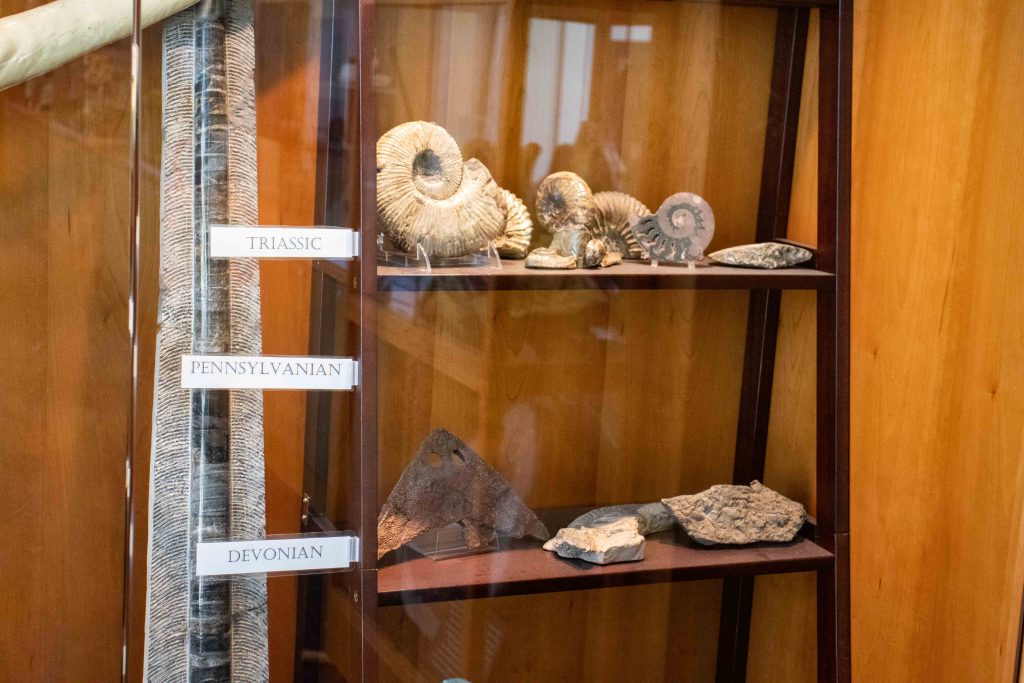Creation Museum links God and science

A quiet room located in the Creation Museum at the Center for Natural Sciences, overlooking a view of the Academic Lawn, offers students a relaxing place to study. But the fossils adorning the room give a glimpse into the theory of Young Earth Creationism.
Looking at the fossils on the wall, there are two main cases that immediately catch one’s eye. One contains various replicas of skulls of apes from after the Genesis Flood; the other contains various replicas of human skulls.
Dr. Timothy Brophy, professor of biology and director of the Center for Creation Studies, explained that when looking at these cases, they have intentionally kept the ape case and the human case apart to showcase Liberty’s belief that man did not evolve from apes but has been made distinct from the animals due to the Imago Dei. Imago Dei refers to the idea rooted in Genesis 1:27, which says, “So God created man in his own image, in the image of God he created him, male and female he created them” (ESV).
Though various subgroups of the human fossils exist, such as Homo sapiens, Homo erectus and Homo floresiensis, man retains the image of God. Brophy explained that since these fossils are from after the Genesis Flood, the human fossils displayed are all descended from Noah.

One way to understand these different categorizations is to compare it to today and how there are still physical differences between people from all around the world. Environment and DNA affect how they look. Brophy said the differences between the fossils highlight how unique God made man, rather than support the theories of evolution.
At the end of the hall resides a display of fossils, currently on a long-term loan from Dr. Randall Price. The fossils were taken from various levels of the Earth’s crust.
Though many secular scientists date these in terms of millions of years, Brophy said the Creation Museum describes the dating in terms of before the Flood, from or during the Flood and after the Flood, along with an approximate timeline. By incorporating the Flood into their explanation of the fossil record, it explains the groupings of various fossils and the layering of the rock with the biblical worldview.
In that display, one fossil is on loan from the government. However, one specimen in particular — the Allosaurus ribs — was discovered by a Liberty professor and students in 1989 in Colorado. Brophy explained that this is one of his personal favorite fossils present, not only because of the amazing connection to Liberty, but also because of the mystery surrounding it.

An Allosaurus is like a mini-Tyrannosaurs Rex, and while the Liberty team found almost an entire Allosaurus, Brophy said the department is not sure where all of it is now. Only the ribs and potentially an arm remain at the museum. The hallway outside the Creation Museum displays a replica Allosaurus skull, so students can imagine what the great dinosaur once looked like.
Through all of the fossils on display, replica and real, the Creation Museum remains a reminder of Liberty’s view that man is distinct from animal and there does not need to be a separation between faith and science.
Students can learn more about creation studies by visiting the creation display or signing up for one of the two major classes offered in this field, CRST 290 History of Life and CRST 390 Origins. They can also add creation studies as a minor and/or attend one of the various opportunities throughout the semester to hear open lectures on creation studies from Liberty University professors and special guests.
The next creation studies lecture will be Monday, Feb. 20 at 10:30 a.m. in the Center for Natural Sciences (CNS) 128.
Auld is a feature reporter for the Liberty Champion
